Are you a scientist, or more of an artistic person? Or maybe you’re a bit of both? Do you care? And does it matter?
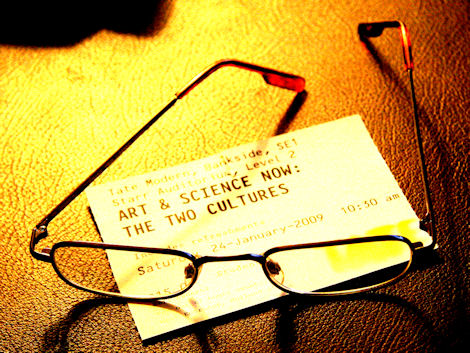
It mattered to CP Snow in 1959, when he wrote the essay ‘The Two Cultures’. Snow saw society split into two groups, or cultures: the artistic intellectuals and the natural scientists (natural because they study the natural world). Each misunderstood the others language, ideas, and contribution. The relationship was often one of unproductive hostility.
Fifty years on, towards the end of last month, I joined the London Consortium’s ‘Art and Science Now’ programme, to see how Snow’s ideas are standing up in the eyes of leading figures from the world of arts, science, public policy, science communication and philosophy.
This post is part summary, part observation, and part photo gallery (thanks largely to Sven Klinge, whom I met at the conference and who provided most of the pictures here). Not all the speakers from the Dana event are reported here. Don’t read any significance into that – its just a time issue. Also, plenty of additional ideas came through in the final panel session and Q&A, which are likely to inspire future posts – but there’s more than enough to be going on with here. The full event ran for three days, 22nd-24th January; I joined on 23rd and 24th.
NOTE: now includes a summary of Gillian Beer’s paper not included in the original post
First Day – 23rd January, Science Museum’s Dana Centre
The session kicked off with Steve Connor, Director of the London Consortium, introducing keynote speaker George Rousseau.
Reading a prepared text, Rousseau’s talk majored on the virtues and challenges of cultural collaboration framed as inter-disciplinary working, including the concept of ‘bridging’.
Today, multi-disciplinary working is needs-driven by otherwise insoluble complex problems, yet we attack and treat with suspicion those who move between disciplines – “we rush to shoot them down”. Acknowledging that the best minds have always worked in multiple fields (Rousseau made the standard reference to Lunar Men here) doesn’t seem to help us.
Moving on to ideas of responsibility, can those on each side of the science / humanities divide understand each other sufficiently to be conscious of their respective responsibilities in the world? Scientists might understand the arts better than artists understand science, but so what if they can’t sort out their responsibilities? Can we not work with a unified sense of knowledge to achieve that?
Rousseau’s vision is for a world in which we all work across boundaries and know what we have to do (this is what academics call a crude summary). Rousseau went on to discuss at length what that vision might mean within academia, such as the emergence of multi-disciplinary selection committees filling leading academic appointments with multi-skilled candidates.
Rousseau’s Q&A was short and disappointing. A question on unified knowledge – asking how the different ways in which artists and scientists define the word knowledge might prevent sensible commune, was not engaged with. I took the question to mean knowledge derived from ‘feeling’ – acceptable and embraced by the artist, as opposed to the scientists’ equivalent based on the ‘rational’. But Rousseau simply declared the word knowledge to be a lexical term and that he didn’t really know what knowledge was. Considering the forum, I found that answer surprising and unfulfilling.
The Science Museum’s Robert Bud opened the afternoon session with his keynote speech. Opening his talk with a photo of Dawkins’s atheist bus, Bud quickly took us back a hundred years, to the split between the ‘two sides of the road’ in South Kensington – close enough to what we call the V&A and the Science Museum today. The ‘arts side’ was painted as a backward looking centre for the maintenance of elitist taste; the science side more practical and forward looking, representing progressive materialism and a rejection of the spiritual. The tension between these, Bud argued, formed the roots of Snow’s cultural divide.
Bud set his mission to the clarification of Snow’s real meaning. In developing the story, he pointed to the iconic importance of Francis Crick’s DNA double helix, not only as the basis for life and replacement for the soul, but as the basis for Crick’s, and later Snow’s, fundamental beliefs.
Referencing an essay by Jacob Bronowski, Bud linked Snow to Crick. With a letter from Snow to Bronowski as evidence, he showed that the content of Bronowski’s essay, ‘the abacus and the rose – a dialogue concerning the two world systems‘, was aligned with the real intent behind Snow’s essay. Bronowski couched his text as a dialogue between Potts, a Cricks-type scientific stereotype, and Harping, a Kingsley Amis-type reader in English. In the fictional debate, the artistic protagonist sees no beauty in life unless there is some subjectivity or element of human judgment associated with it. Potts on the other hand, the scientist, has no need of that. In other aspects too, the Harping character generally meets our modern stereotype of an anti-technology, anti-progress, luddite. This is starting to remind me of the themes in Dawkins’s ‘Unweaving the rainbow‘.
Sure enough, having implicated Crick with Bronowski’s Potts character, and aligned Bronowski’s views with the intent of Snow’s essay, Bud now linked Crick to Richard Dawkins. Not only through their shared activity on genetic themes, but also through Dawkins’s atheism, expressed so recently on the sides of another British cultural icon – the London Bus.
Through this elegant, methodical, approach with use of evidence, Bud had boxed down Snow’s intended meaning to the sort of black and white intellectual stand-off that is unfashionable in some quarters. Alan Sokal would later show a similar level of attention to the content and bounding of his argument.
Bud concluded, for the avoidance of any doubt, with this reference to the two cultures debate: [it has] “not been primarily about the conflict between academic disciplines, between whether history or physics is more important, it’s been about materialism against the reality of non-material entities; about god and life. Thank you”
Second Day – 23rd January, Tate Modern Art Gallery
This was the first time I’d seen Marcus du Sautoy in the flesh.
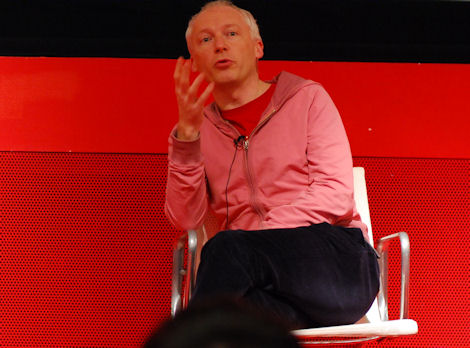
With an appearance and demeanor somewhere between a children’s TV presenter and a younger Jasper Carrott, wearing a tee-shirt emblazoned with the phrase ‘i are scientists‘, I can see how he’ll fit well into Dawkins’s old job, but definitely not his shoes.
Full of energy and wit, there is also something of the diplomat about du Sautoy. The recurring theme of ‘bridging’ came up, with maths as the unlikely bridge between science and the arts. Du Sautoy explained the mathematical structure of music; he is involved in a range of projects that link the two. He was sympathetic and supportive of the ‘artist in residence’ type of cross-rift exchange that one audience member was involved with.
Sad as it might seem, I’ve often pondered on behalf of Anthony Grayling, as to the wisdom of a book-branding philosophy that entails the title ending with the words “…of things”: ‘The Mystery of Things’, ‘The Reason of Things’, ‘The Meaning of Things’, ‘The Heart of Things’, ‘The Form of Things’ , for one tract of his extensive range of popular philosophy books. Maybe it’s just me, but agonising over a purchasing decision in a bookstore, I can never remember which of these ‘things’ editions I already own, and invariably end up leaving the store empty handed.
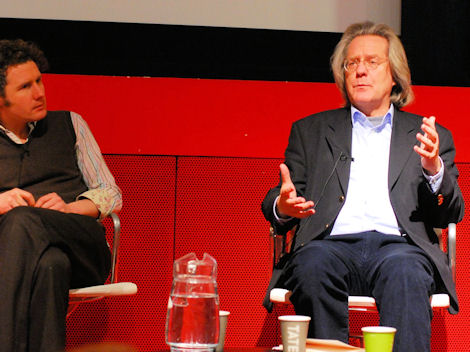
Yet Grayling remains the philosopher I feel I could most comfortably engage with in chat over a beer. His ability, without patronising, to transpose complex ideas into the common tongue, combined with an unforced sense of humour, is appealing.
Grayling approached Snow from historical and educational perspectives. Again, as Bud had stressed earlier, Snow was late to the debate. In the early decades of the 20th century, Wittgenstein , whose texts Grayling reminded us would be familiar from our previous night’s bath time reading, had defended the ‘feeling’ world of morality and religion from the reductive encroachments of the empirical scientists’ world view.
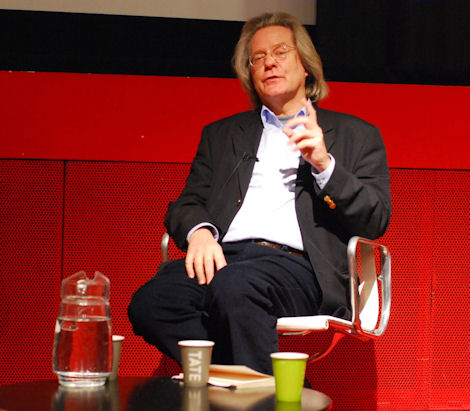
In 1880, at a time when the so-called Civic Universities, like my alma-mater Birmingham, were for the first time concentrating on scientific and practical subjects, Thomas Huxley addressed the issues perceived around the arts and sciences, spelling out the importance of a scientific education for all in understanding the world. In retort, Huxley’s friend Matthew Arnold, while agreeing with much of his colleague’s argument for science, strongly defended a complementary role for the humanities as a vehicle for human reflectivity – amongst other virtues.
Yet class was to override any happy balance that the Huxley-Arnold discourse might have anticipated. The wealthy and influential social elite, trained in the classics from school through to Oxbridge, were empowered and equipped to exercise a disproportionate influence over society, compared that is to the growing, parallel yet separate, class of technically proficient industrialists.

Key developments in the twentieth century, Grayling argued, were a change in status for science in recognition of its indispensability to modern infrastructure and the exercise of war, and the increase in complexity and requirement for specialism in scientific pursuits.
Specialism led to streaming in the schools system, separating the population at an early age into classicists and scientists. It was this galvanisation through specialisation of an already divisive educational system that, Grayling argued, had prompted Snow’s commentary. The powerful elite saw the importance of science, but without understanding. It prompted the pithy rationale of keeping the “expert on tap, not on top”. Efforts by the ‘new’ universities to introduce reciprocal training for arts and science students enjoyed abject failure.
In summing up the position today, Grayling considered that in important respects, and specifically with regard to the scientific literacy of the general public and elected officials, Snow’s gap is very much wider fifty years on. Further, this condition is damagingly influential on how scientific issues are being read. Grayling pointed to how the public debate on evolution could only persist through ignorance of biology, causing a mistaken belief that there is any substance at all in the contrary argument. The tradition of thinking in the humanities is, Grayling believes, more towards the need for neat answers and closure to issues and debates, representing the antithesis of the scientific acceptability of open ended questions.
Grayling closed with an appeal for scientific literacy, achieved in part through a change in attitude towards, and engagement as adults with, life-long learning.
The relevance of Charles Darwin to a debate on Snow might not be obvious; yet Gillian Beer made it so.
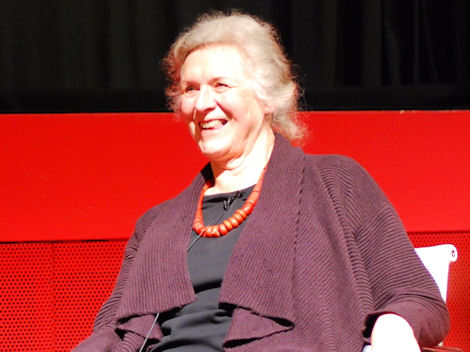
Before developing her main theme around extinction and Darwin, Beer informed us that Snow’s main reason for wanting to see science and technology working effectively in the world was so it could be used to combat global poverty. Maybe that is a less well known, more human, driver in the debate around Snow’s motivations?
As it turns out, as illustration, Darwin’s attitude to extinction, and the various interplays of scientific, social, and personal experience that influenced that attitude, have much to inform our thinking. When human beings are involved, thoughts and actions are rarely down to science alone.
For Darwin, said Beer, extinction was an ordinary necessity in the process of natural selection. Without extinction there would be no new animals, no improvement. And anyhow, the whole process dovetailed nicely with the Victorian cultural values of progress and hierarchy.
There was some sadness attached to species loss, yet the world remained full and in balance. Why react? Extinction is a gradual process; Darwin scoffed at the idea of cataclysm. And there was every reason to believe the animal kingdom could continue to look after itself well into the distant future.
The very far future was different though. A cooling sun and dying earth played on Darwin’s mind. The religious had their afterlife, but for Darwin the finality of an extinction of man was an intolerable prospect.
How different things are today.
Extinctions are more simultaneous and widespread; we contemplate E.O.Wilson’s ominous forecast of 50% species loss over 50 years. And we feel guilt. We can place five historical mass extinctions, and further cataclysm is a real prospect on a warming earth.
More positively, stuffed animals in glass cases have made way for movie films of living, moving, animals. And, while like Darwin, we might not see a personal eternity, our understanding of genes at least gives us some intellectual compensation that something continues.
In her close, Beer came back to the theme of the interaction of science and culture over time, [concluding that while]:
different elements of Darwin’s theory point in different directions, and have been pressed into service by opposed ideologies; that does not undermine his experimental evidence or his theoretical reach, but it does I think demonstrate how the cultures of scientific enquiry, social assumption, and bodily experience all interact, over time, to change ideas. Thankyou.
This was my second serving of Ben Goldacre in a week; having heard him speak at a Centre For Inquiry event reported here.
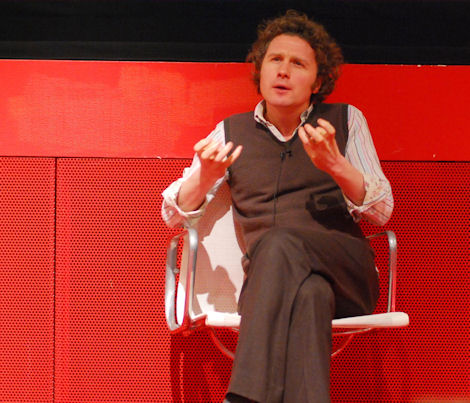
Today, less spontaneous and the better for it, Goldacre’s rant was unambiguously focused on the evils of the ‘humanities graduate editors’ of mainstream news media.He really hates these guys, whom for Goldacre most closely resemble the Snowian (Snowic?, Snowoid?) stereotype of artist as scientific philistine – ignorant, and dangerously active with it.
Goldacre’s thesis is that we have moved beyond a condition of mere disconnect in which arts graduates are dismissive of science, to one in which the same group feel entitled to make comment in areas and on subjects they know nothing about. He resents the lack of in-depth science reporting in the mainstream media and, as a mantra now, champions the non-specialist but educated reader – the people who “did bio-chemistry at Leicester, and now work in senior management at Marks & Spencers“. He went on to illustrate his talk with slides covering a whole range of mercilessly crass and inaccurate reports extracted from his beloved tabloids and equally unsafe broadsheets. For more, see Ben’s book Bad Science for an enjoyable read.
Goldacre gets his important points across with a sense of fun. That said, today’s comic highlight was at his own expense when, during the final panel session, a deferential compliment back-fired. Having answered a string of audience questions specifically addressed to him, Ben now paused to announce that as a mere ‘D-list’ public intellectual he should defer to the ‘B-list’ public intellectuals – Grayling and Sokal – seated either side of him.Ben’s categorisation was arguably correct for a small population that counts Dawkins in its number, but that didn’t stop Ben changing colour in response to Grayling’s playful objection to his grade.
Jonathan Miller doesn’t like to be called a polymath.

But what do you call a writer, performer, neurologist, and internationally distinguished director of theatre and opera? Perhaps Steven Connor’s introduction of Miller as an intellectual amphibian was more acceptable; it got a smile.
Sitting across from his interviewer, Associate Director of the London Consortium Colin McCabe, Miller played upon his intimidating status to the full, a status that has earnt him the right, and the expectation from others, to speak plainly. He did so with a vengeance.
The idea of ‘Two Cultures’ would be first a mystery, and second anathema, in the household of Miller’s formative years. Engaged equally and variously as artists and scientists, the family were simply doing what intelligent people did; they flitted effortlessly between interests.
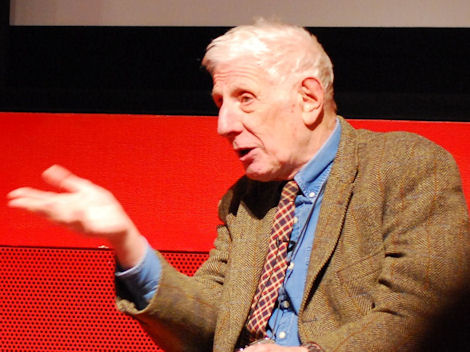
Schooling had played a part, but only in the form of an unruly master who ignored the formal curriculum, a reference that put me in mind of Richard Dawkins’s reminiscing about his happy days at Oundle School. But how far would those examples get, elitist at best by current fashion, as educational models today?
With his neurologist cap on, Miller shared his fascination with the mind’s learning and skills capabilities. For example, taking three days off from a failed activity can result in a skill magically appearing, subconscious processing having kicked in unbeknown.
Miller’s latest interest is to form shapes and assemblies out of metal, just structures that interest him and which, again, he resists to label as art. Art and science are very different things to Miller. Most art is “to do with people doodling“, while science is “quite clearly directed enquiry prompted by a context which determines what is going to count as an interesting problem“. He sees the “rightness” of what constitutes a satisfactory artistic endeavour is totally different to the “rightness” of what can be concluded from science.
Miller took a similar line to Bud, in so far as he saw the important differences between art and science as quite fundamental. As for the two helping each other out, Miller has “deep suspicion of this notion of being artist in residence‘, a reference to an earlier audience point, and what he saw as an unnecessary formalisation given that art and science are ‘in residence’ within each of us all the time. He pointed to a nine year period between 1905 and 1914, when interesting developments ranging from relativity to cubism, to the de-construction of music, appeared as the products of a natural cross-fertilisation of interests. The first cubist artists, responsible for the development of military camouflage, were not “artists in residence“, but “artists in uniform“, their input naturally falling into place.
Miller’s point, that the propensity for the arts and natural sciences to unconsciously intermingle is a product of the time we are living in, may well be valid. Yet do we live in such a golden age today? Maybe we need to make some clunky ‘artist in residence’ type gestures to kick the right-thinking along. Miller conceded that the very complexity of science today made polymathism [my word!] a challenge; there are too few hours in the day. Indeed, to expand on a recurring theme, it is problematic enough today for scientists in the same subject area to understand each others’ work. In my experience, it is the same complexity and associated promise of narrowness that drives potential candidates away from a training or career in science.
In a forgivable ploy to avoid final-session empty seat syndrome, Alan Sokal was held back till the 4.00pm slot.

Sokal is something of an icon for followers of the arts-science debate. In 1996, he wrote a spoof academic paper parodying the pseudo-intellectual content and style then being used by an academic group known as the cultural relativists – signatories to a particularly strong flavour of post-modernism. Their thesis as it applies to science is that science is made up – constructed – by people to meet their political wants. Any cultural relativist could write a ten thousand word essay on how over-simplistic that definition is; but that’s partly the point. There is a socio-cultural angle to the most astringent definitions of science, but in the 80s and 90s it all got out of hand. Meanwhile, Sokal’s meaningless paper was accepted and published by the journal ‘Social Text’. His own revelation that the paper was meaningless did much to expose the low standards of evidence and understanding in the prevailing discourse of the cultural relativists. It also precipitated what became known as ‘the science wars’.
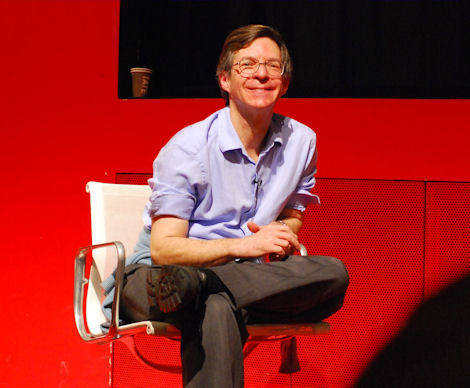
Speaking on his birthday, Sokal immediately set out a field he could play on. That meant focusing on the relationship of science and scientific inquiry with society as a whole, rather than the Snow question per-se, and defining exactly which definition of science he would be talking about.
Sokal’s was an appeal for a scientific world view in which we are all scientists, some better than others perhaps, but all working to the same rules. The corner stones of this vision would be clear thinking and a respect for evidence.
Clear thinking meant also the clear writing that Sokal, and earlier Grayling, had demanded. But what is science? It suits some academic commentators not to bolt down definitions in this way, they see it as restrictive and narrowing of debate, but Sokal is firmly out of that camp. It’s worth pondering Sokal’s four definitions of science:
- It denotes an intellectual endeavour aimed at a rational understanding of the natural and social world
- It denotes a corpus of currently accepted substantive knowledge
- It denotes the community of scientists with its mores and social and economic structure
- It denotes applied science and technology
Again, there are those who would argue the first two cannot be discussed outside of the second two, and would attach especial dependency of 1,2,and 4 on 3 – the social aspect. Not so Sokal.
As if nothing had changed in the thirteen years since his ‘exposure’ publication, he launched a scathing attack on those who would deny that scientific knowledge constitutes objective knowledge of a reality external to ourselves. In these moments, in that lecture hall, it felt like Snow’s rift had evaporated – ‘science’ had won. There was no robust response from the floor as Sokal ridiculed one sociologist after another by relaying quotes from his book Beyond The Hoax. For example:
the validity of theoretical propositions in the sciences is in no way affected by factual evidence – Kenneth Gergen
the natural world has a small or non-existent role in the construction of scientific knowledge – Harry Collins
for the relativists such as ourselves, there is no sense attached to the idea that some standards or beliefs are really rational as distinct from merely locally accepted as such – Barry Barnes & David Bloor.
For Sokal, this type of writing, and the thought behind it, aims to confuse truth with claims of truth. Of course, any post-modernist worth his salt would head that one off at the pass with a denial of there being any absolute truth. Sokal conceded that the more extreme forms of post-modernist thinking were now in retreat, in part due to his own efforts, but mostly due to the example provided by George Bush of where “science bashing” can worryingly lead.
A diversion into pseudoscience complemented Goldacre’s talk and led into the real point Sokal wanted to address – the universal applicability of the scientific method across all areas of human activity. Why do we use one set of standards for evidence in physics, chemistry and biology, and then relax the standard for religion, medicine or politics? Sokal interestingly framed his argument for a unified approach as the “inverse of scientific imperialism“, whereby science should be seen as just one instance of the application of a rational world view in which empirical claims are supported by empirical evidence (the antithesis of dogma).
So at the end of the conference we had returned to a dichotomy of rational and dogmatic world views that Bud, the day before, had used to characterise and clarify as Snow’s true intent, and which Grayling had reinforced as the real issue. And in conclusion to his talk, Sokal stated his belief that the transition from the dogmatic to an evidence-based world view is very far from being complete.
Notes
Gillian Beer was King Edward VII Professor at the University of Cambridge
Ben Goldacre is a writer, broadcaster, and medical doctor. He has a weekly Bad Science column in the Guardian newspaper
Anthony Grayling is Professor of Philosophy at Birkbeck, University of London
Marcus du Sautoy is Charles Simonyi Professor for the Public Understanding of Science and Professor of Mathematics at the University of Oxford
Jonathan Miller is a neurologist, writer, TV presenter, director of plays, and many other things!
Alan Sokal is a Professor of Physics at New York University and Professor of Mathematics at University College London
Mainstream Press on this topic
‘The crossing of the intellectual divide‘ – Steve Connor, The Indpendent (newspaper) 6th Feb 2009. Connor’s article makes mention of events at the day of the conference I did not attend at Birkbeck College, so worth a read.

This is good stuff. It seems that over the last couple of years a new rationalist movement has sprung up, and networks of rational-minded blogs such as this one are at the heart of it. I only wish “blog” weren’t such a buzz word, misused by “web 2.0” gurus, because it makes what I just wrote appear to be meaningless wankery…
If I may make a prediction, it’s that we are in for a few dark years, irrationality’s last hurrah, before the pendulum swings rationality’s way for a generation or two.
Tim,
Being stuck on the wrong side of the Atlantic and unable to attend the event, very much appreciated this summary – thanks!
You’re welcome. I think London Consortium may eventually release a recording of the whole smash. Conscious I short-changed some speakers here, but believe the balance of feeling was as reported.
NYT article re Two Cultures http://www.nytimes.com/2009/03/22/books/review/Dizikes-t.html?_r=2&8bu&emc=bub1